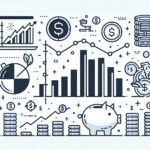
Will Trump’s Tariffs Transform the Federal Reserve’s Monetary Policy?
Tháng 4 8, 2025
Fitch Ratings Downgrade: What It Means for China’s Financial Future
Tháng 4 8, 2025Here’s your content with backlinks included:
Unraveling the Economic Impact of Escalating Tariffs: Insights from BMO Analysis
In a detailed analysis conducted by BMO, the ongoing rise in tariffs is significantly shaping the economic landscape, prompting experts to exercise caution before declaring a “risk” bottom in the markets. As tariff negotiations continue to evolve, understanding their implications becomes critical for investors, stakeholders, and consumers alike.
Current Economic Climate: Tariffs and Their Consequences
Escalation of Tariffs: As of April 2025, Canada has enacted substantial retaliatory tariffs, imposing a daunting 25% tax on C$155 billion worth of U.S. imports. This sharp spike in tariffs is projected to exacerbate inflationary pressures on imported goods, further complicating an already tenuous economic recovery. With economic growth prospects already facing challenges, this tariff escalation serves as an additional headwind, stifling expansion in key sectors and contributing to increased cost burdens for consumers.
Recession Risks: The BMO analysis has raised alarms regarding the heightened probability of a recession, estimating the likelihood of such an event to exceed 50% within 2025. This apprehension stems from the dual threat posed by ongoing tariff impacts and a decline in consumer sentiment. As confidence wanes, consumer spending may decline, leading to a ripple effect that reduces economic activity and hampers job growth—a scenario that economic stakeholders must monitor closely.
Market Reactions: Volatility and Investment Strategies
Volatility in Markets: The response from equity markets has been swift and tumultuous following the latest tariff updates. Major indices, including the S&P 500, have recorded notable declines, particularly within sectors that are sensitive to trade dynamics, such as technology and consumer discretionary. This market volatility can be attributed to uncertain investor sentiment regarding the future trajectory of tariffs and their broader economic ramifications, highlighting the need for vigilance amid a fluctuating landscape. Some investors may find insights on disciplined investment strategies useful, as discussed in the blog about key investment mistakes to avoid in 2023.
Investment Strategies Amidst Turbulence: Despite the prevailing pessimism, some analysts maintain that current market conditions might unveil potential buying opportunities for savvy investors. However, such strategies come with a caveat—investors should prioritize defensive positioning to navigate the erratic markets fueled by rampant tariff instability. Pioneering investment approaches that account for these risks could yield long-term benefits even in times of uncertainty. Strategies to identify undervalued stocks for potential long-term gains can be informed by the principles of value investing, as advocated by investor Joel Greenblatt.
Regional Impacts: Disparities Across Sectors and Economies
Sector-Specific Challenges: The fallout from the escalating tariffs is expected to disproportionately burden specific sectors. Particularly, the technology industry, which maintains deep connections with China, may encounter significant obstacles. Conversely, sectors less affected by international trade disputes could emerge more robust, demonstrating resilience amid unfavorable economic conditions. The interplay of global trade dynamics and economic conditions is crucial for understanding these disparities, as highlighted in discussions about strategic moves by China.
Canadian Economic Position: According to BMO’s findings, while Canada started 2025 on a relatively strong footing, persistent tariffs could usher in a period fraught with difficulties. Prolonged tariff imposition may culminate in a moderate recession defined by several quarters of negative growth, leaving policymakers and consumers to grapple with the economic repercussions.
In conclusion, BMO’s recent insights underscore the intricate and challenging nature of the current trade environment. The intricate interplay of tariffs, inflationary pressures, and economic forecasts paints a complex picture, marked by both caution and the prospect of opportunistic investment. As stakeholders navigate this evolving landscape, a nuanced understanding of the implications is essential in making informed decisions amid economic uncertainty.

